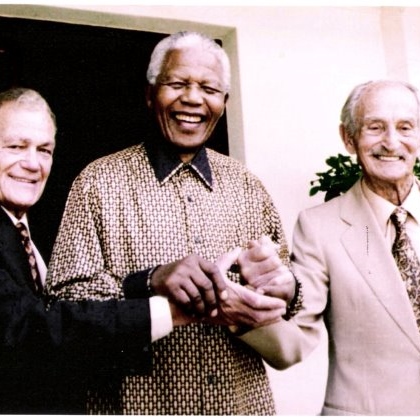click to dowload our latest edition
CLICK HERE TO SUBSCRIBE TO OUR NEWSLETTER


Published
7 years agoon
By
adminDAVIS SAKS
The Dalai Lama said he had often met with extraordinary people, including spiritual leaders, royalty, Nobel laureates and presidents, but he invariably found, on meeting them, that those people were not as large as their reputation. Only in Mandela’s case did he find the person larger than the reputation.
What did Mandela mean for South African Jews specifically? The question is a complex one, and in attempting an answer, it is important to reflect the nuances and ambiguities involved. On the one hand, during the apartheid era, Jews belonged to the privileged white ruling caste, and in a collective sense, never took a stand against that system until very late in the day.
On the other, no sector of the white population produced so high a proportion of individuals who fought against the apartheid system, many of them side by side with Mandela himself.
In looking back on Mandela’s relationship with South African Jewry, taking justified pride in and inspiration from these individuals must always be balanced by the recognition that during the apartheid years at least, the Jewish community as a whole was not part of that story.
Rather like Gandhi, who commenced his career in South Africa as a lawyer, but was gradually drawn more and more into the political arena in response to the injustices meted out to his community, Mandela first trained and worked as a lawyer before the anti-apartheid struggle took over his life.
Famously, it was Lazer Sidelsky who enabled him to go into that field by taking him on as an articled clerk in his law firm, at a time when engaging young blacks in that capacity was all but unheard of.
Mandela’s fellow clerk, Nat Bregman, became his first white friend in Johannesburg and, as a member of the Communist Party at the time, also played a part in his early political education.
Mandela went on to study law at Wits. There he established enduring friendships with such future anti-apartheid campaigners as Joe Slovo, Ruth First, Jules and Selma Browde and Harry Schwarz.
Jules Browde, later to become one of South Africa’s most respected senior counsels, was the first of many Jewish lawyers to represent Mandela. The case concerned an attempt to force the law firm established by Mandela and Oliver Tambo, to vacate its premises in the city centre under the Group Areas Act.
Appearing before the Land Tenure Advisory Board in Pretoria, Browde was able to obtain permission for them to stay where they were.
Jewish lawyers were prominently involved in defending Mandela in the various political trials in which he was involved, among them Isie Maisels (who successfully headed up the defence team during the Treason Trial), Arthur Chaskalson, Joel Joffe and Sidney Kentridge.
Ironically, Percy Yutar, the notoriously over-zealous state prosecutor in the Rivonia Trial in which Mandela and various others were sentenced to life imprisonment, was also a prominent Jewish community member.
As he moved increasingly into political activism, Mandela came more and more to be associated with Jewish-born anti-apartheid activists, mainly on the far-left of the political spectrum.
Thirteen of his fellow defendants in the 1956-1961 Treason Trial, for example, were Jews, among them such Struggle stalwarts as Lionel Bernstein, Ben Turok, Joe Slovo, Leon Levy and Ruth First.
Among the founders of the underground military wing of the African National Congress, Umkhonto we Sizwe, were Dennis Goldberg, Harold Wolpe and Arthur Goldreich (a volunteer in the War of Independence who later settled in Israel). A strikingly high proportion of those responsible for organising the 1955 Congress of the People and drafting of the famous Freedom Charter, were of Jewish origin.
Before his imprisonment, Mandela worked closely with the journalist Benjamin Pogrund, whose hard-hitting exposés of the injustices of the apartheid system made him the target for continual police harassment.
Forced to go underground during the early 1960s, he stayed at a number of “safe houses”, including the Berea flat of Wolfie Kodesh and the home of Cyril and Raie Jones in Cyrildene.
While on Robben Island, his cause and that of his fellow prisoners was strenuously pursued by Helen Suzman, at the time the sole representative of the Progressive Party in Parliament.
Suzman was able to visit the prisoners and afterwards obtain certain improvements in their conditions. Numerous Jewish former activists who went into exile campaigned ceaseless for Mandela’s release, among them Norma Kitson in London.
After Mandela was released from prison in 1990, he and the mainstream Jewish leadership forged a cordial relationship and many leading Jewish businessmen and philanthropists, among them Eric Samson, Raymond Ackerman, Meyer Kahn and Bertie Lubner, were brought on board to assist in addressing the legacy of poverty and inequality left by the apartheid system.
He became especially close to Chief Rabbi Cyril Harris, a charismatic leader who wholeheartedly embraced the new democratic dispensation and encouraged the greater Jewish community to do likewise.
The South African Jewish Board of Deputies met with Mandela regularly, and its leadership accompanied him on a visit to Israel after he had stepped down as president in 1999.
On the Israel-Palestine question, Mandela was deeply committed to the attainment of Palestinian statehood, but at the same time recognised that this had to be accomplished through peaceful negotiations and steadfastly affirmed Israel’s right to exist within secure borders.
Few can doubt that had his example been followed by the Palestinian leadership, a peaceful, two-state solution to the conflict would have been achieved decades ago.
Next week marks the birth of Nelson Mandela, a true colossus on the stage of history. In remembering it, South African Jewry can take pride in how many of its members contributed to what he was able to achieve, for his own people and for humanity at large, and hopefully be inspired to continue building on his legacy.
